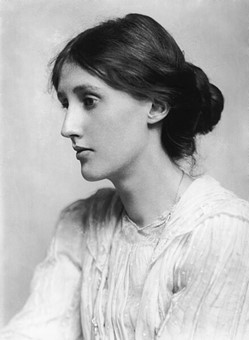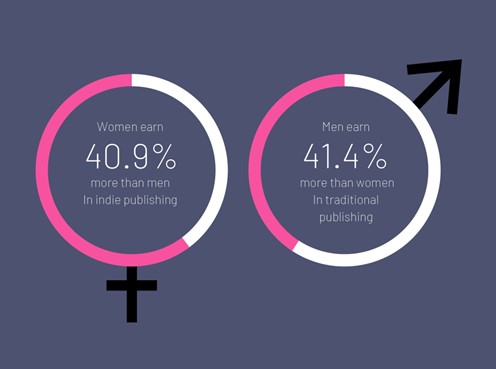This blog post follows the launch of the virtual exhibition for the Women Writing Lockdown project, a multi-disciplinary, AHRC-funded project that captures women’s experiences of the first phase of lockdown in the UK during the COVID-19 pandemic. Here, Amy Thomas reflects on the connections between gender, copyright and remuneration following a series of surveys on authors’ earnings.*

Figure 1: Virginia Woolf (1882-1941)
Published in 1929, Virginia Woolf’s seminal essay A Room of One’s Own, considers the ways in which law and custom have historically prevented women from having property rights and intellectual freedom. Considered a key work of feminist criticism, Woolf attributed the (then) absence of women writers to be a result of a lack of opportunity for women to succeed in writing, rather than a lack of talent. More fundamentally, A Room of One’s Own is a musing on poverty and the gendered elements therein (personally, I have found it unclear whether Woolf’s advocacy was directed to all women, or only those of ‘genius’). It is ultimately about the basic material conditions that make the realisation of intellectual and creative activity possible: that ‘one cannot think well […] if one cannot dine well.’ Woolf’s suggestions for remedy in this essay are comparatively modest: that a woman only needs ‘money and a room of [one’s] own if she is to write.’ Readers might be curious to know that Woolf stipulates the amount of money a woman needed to succeed as a writer per annum: £500 a year in 1929 – around £26,000 today – roughly concurrent with a living wage.
Whilst data on the lived reality of women writers was rarely collected or preserved in 1929, our recent research on authors’ earnings has been documenting, empirically and longitudinally, the material conditions in which authors live. Our curiosity about this data is mainly driven by the connection between copyright, which allows authors to derive financial benefits through the exploitation of their works, and routes to fair remuneration. As a facially neutral law, the purported benefits of copyright should, in theory, benefit all genders equally when it comes to ‘a room of one’s own’.
The gender pay gap in the writing profession: an overview
In our survey of UK authors of tax years 2020/2021 (in collaboration with ALCS), we found that women authors see a larger drop in their earnings (21% in real terms between 2017 and 2020, against 10% for men), resulting in a gender pay gap between men and women of 41.4%. This contributes to an increased gender pay gap between authors, which was already substantial at 33% in our previous survey of tax years 2016/2017. The result is that whilst men typically earn around £29,000 per annum, women earn £17,000: rather below Woolf’s estimation in 1929, and indeed rather below a living wage.
In that report, we noted the unique temporal effects of the COVID lockdown, which emulated the lack of leisure time and confinement to the domestic sphere described in Woolf’s essay. A combination of gendered expectations around home working, childcare, and care responsibilities appears to have had a direct impact on women’s creative labours. We found that women were more likely to report one of the extreme experiences of the COVID lockdown; either substantial decreases in earnings (over 22%), or substantial increases (almost 5%). Men, by contrast, were more likely to report that their earnings have stayed the same throughout the pandemic (almost 50%). We found similar patterns in gender differentials for the effect of COVID on the professional lives of writers more broadly conceived. More women experienced the very negative (over 10%) and very positive impacts (almost 2%) of the pandemic, whereas men more frequently reported no impact whatsoever (almost 50%).
‘I’m hoping that I can increase my income this year but like many women who had childcare or caring obligations during the pandemic, I feel like my career has derailed and won’t progress like it should have had we not had the pandemic.’
We concluded that gendered expectations in terms of emotive labour resulted in a ‘household subsidy’, with women’s earnings becoming more tenuous and easier to destabilise because of these expectations. This had an acute effect during the pandemic, but is also likely to be a source of ongoing derailment for women’s careers in writing. In this respect, COVID is a useful lens to analyse what we already know from the longitudinal data in this series of surveys (2019, 2014, and 2007): that the success of an author is dependent on access to the right people, at the right time, and even then this may not be enough to substitute for systematic, entrenched factors of discrimination.
Curiously, in our more recent survey of self-publishing ‘indie’ authors (in collaboration with ALLi), we found a reverse gender pay gap, with women both being more present in the self-publishing market, and earning more than their counterparts who are men. In this market, women make up almost 70% of all self-publishing authors and earn 40.94% more than men.

Figure 2: Gender pay gap for indie authors
Whilst we would caution against making too many comparisons between our findings for indie authors and those who use more traditional publishing routes (mainly due to different scopes in respondents’ locations), there is an indication that indie publishing models may be more enabling and sustainable for women when compared with a traditional publishing route. In turn, this would indicate that the main variable in this equation (the intermediary/publishing house) is responsible for perpetuating a form of gendered bias in the writing profession.
Copyright, fair remuneration and gender
In reviewing this data, I was reminded of Carys Craig’s research synopsis for our 21 for 21 project, which reflected on the empirical evidence relating to gender and copyright. She concluded ‘that the beneficiaries [of copyright] have been disproportionately male should, frankly, come as no surprise.’ So many years on it seems that copyright hasn’t translated into the conditions for material wealth, and the intellectual freedom for women, as hoped for by Woolf; rather, copyright is only a source of wealth insofar as the author also benefits from the (implied) characteristics that make its ‘fair’ exploitation possible. It is worth noting that from our findings, the same is also true for authors of colour and authors with disabilities; both groups likewise earn disproportionately less than white authors or able-bodied authors respectively in both surveys. The gendered difference in the exploitation of copyright is therefore only one (albeit important) facet of the shortcomings of the existing system.
In considering possible revisions and re-interpretations of copyright, we have recently made policy recommendations more holistically to improve the sustainability and diversity of the UK writing profession (published by the Policy and Evidence Centre). Most apparent in the gendered context of authors’ earnings is tackling the, rather embedded, ‘freedom of contract’ ethos of the UK, in contrast to the approach increasingly adopted in the EU (more extensively covered by CREATe’s Ula Furgal here). Indeed, in the face of the earnings reality as evidenced by our data, ‘freedom’ has a rather pre-determined result: lower earnings for those groups with disproportionately less bargaining power than the assumed default.
Our research into the earnings and the professional lives of primary creators will continue through 2023 and 2024. Through this, we hope to illuminate the reality of the material conditions of our creators and how this translates to the opportunities envisioned in Woolf’s 1929 essay.
*Note: whilst respondents to our surveys were not solely cisgender men or women, due to very low numbers of respondents for other genders (including non-binary authors) we have not included this in our analysis of gendered differences for the purposes of this blog. Curious readers can check for these details in the original sources: UK Authors’ Earnings and Contracts 2022: A Survey of 60,000 Writers and Indie Authors’ Earnings 2023.


